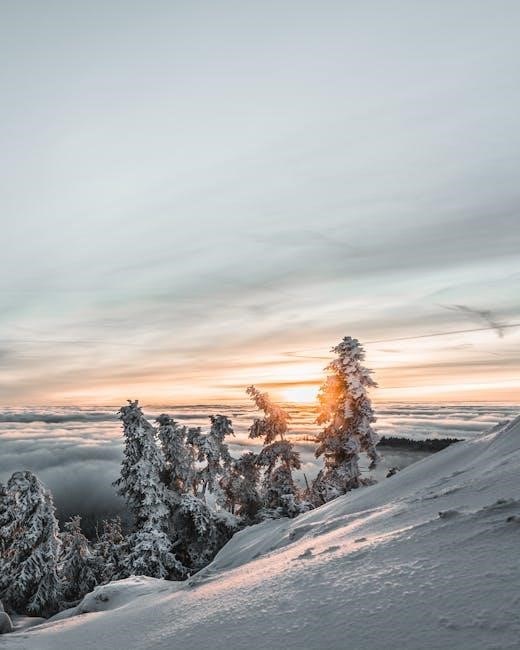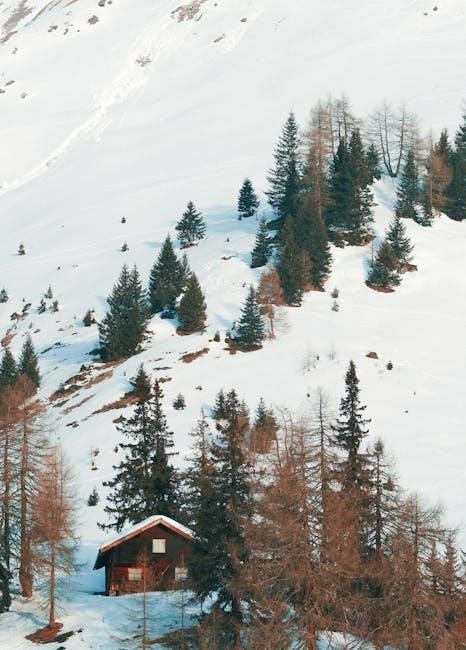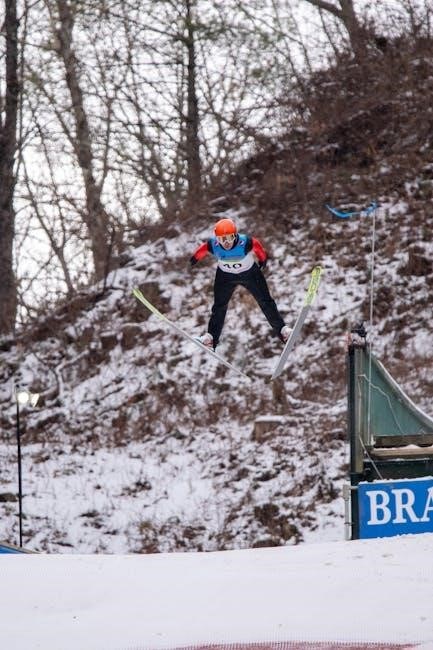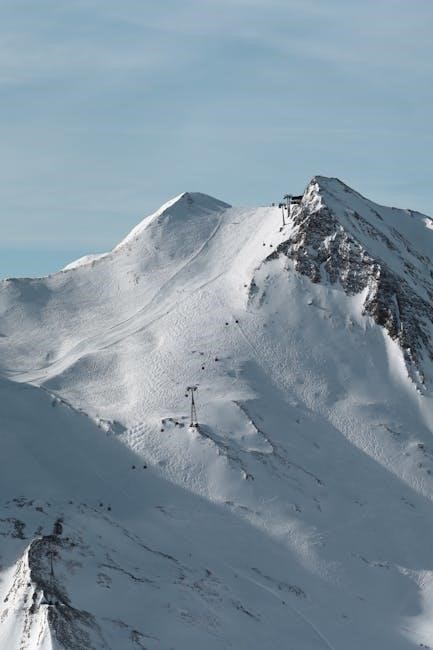Choosing the right ski length is essential for optimal performance and control on the slopes. It depends on factors like height, weight, skiing ability, and style. This guide helps you determine the ideal length for a perfect skiing experience.

Factors Influencing Ski Length
Ski length is influenced by skier height, weight, skiing style, and ability level. These factors ensure proper control, stability, and maneuverability, helping to determine the ideal ski size for different skiing preferences and terrains.
Skier’s Height and Weight
A skier’s height and weight are primary factors in determining ski length. Taller skiers generally require longer skis for stability, while shorter skiers benefit from shorter skis for easier control. Weight also plays a role, as heavier skiers may need longer skis to maintain floatation and balance, especially in powder or variable conditions. A common guideline is to choose a ski length that reaches between the skier’s chin and the top of their head when stood upright. This range provides a balance between maneuverability and stability. However, individual preferences and skiing styles can influence this baseline recommendation; For instance, lighter skiers might prefer shorter skis for quicker turns, while heavier skiers may opt for longer skis to enhance edge hold and stability at higher speeds. Ultimately, height and weight serve as foundational measurements to narrow down the optimal ski length range.
Skiing Style and Ability Level
The skier’s style and ability level significantly influence the choice of ski length. Beginners benefit from shorter skis, as they are easier to control and maneuver, making learning more accessible. Intermediate skiers often prefer skis that provide a balance between stability and responsiveness, allowing them to explore various terrains. Advanced skiers, particularly those who prioritize speed and precision, tend to opt for longer skis, which offer better edge hold and stability at higher speeds. Additionally, skiing style plays a role: all-mountain skiers might choose slightly longer skis for versatility, while freestyle or park skiers prefer shorter lengths for easier tricks and turns. Ultimately, matching ski length to the skier’s ability ensures a more enjoyable and effective experience on the slopes.

How to Choose Ski Length Based on Ability
Beginners: Choose skis around chin height for easy control. Intermediate: Opt for skis slightly taller than chin height for balance. Advanced: Select longer skis, up to head height, for stability at higher speeds.
Beginners
Key takeaway: Beginners should start with skis that reach around chin height for easier control and maneuverability. This length provides stability while learning basic techniques and turning. It allows for better balance and reduces fatigue, making the learning process smoother. Ski length for beginners is generally shorter than for advanced skiers, as shorter skis are more forgiving and easier to handle. This shorter length also helps build confidence on the slopes; Additionally, the ski’s flex and weight should be considered to ensure they suit the skier’s physique. While height is the primary factor, weight can sometimes influence the choice, but the general rule of thumb remains consistent. The right ski length for beginners fosters progress and enjoyment, helping new skiers master the fundamentals without feeling overwhelmed. Always consult a size chart or seek advice from a professional to ensure the best fit for your needs.
Intermediate Skiers
Key takeaway: Intermediate skiers typically benefit from skis that reach around forehead height, balancing stability and agility. This length allows for better control and maneuverability, making it easier to explore various terrains and techniques. For intermediates, the ski length often falls between their height and forehead level, providing a compromise between stability at higher speeds and the ability to make precise turns. This range enables skiers to improve their skills without sacrificing performance. Factors like weight and skiing style may slightly adjust the ideal length, but the general guideline remains consistent. Intermediate skiers can handle slightly longer skis than beginners, as they have better control and strength. However, avoiding skis that are too long is crucial to maintain agility; The right length enhances confidence and performance, allowing intermediates to progress smoothly toward advanced techniques. Always consider personal preference and skiing style when fine-tuning the ski length for the best experience.
Advanced Skiers
Key takeaway: Advanced skiers often prefer longer skis for enhanced stability and speed, typically reaching up to their height or slightly beyond. This length allows for better edge hold and control at high speeds, making it ideal for carving and aggressive skiing. Advanced skiers can handle longer skis due to their strength and technique, enabling them to tackle challenging terrains like steep slopes and deep powder with confidence. The additional length provides superior stability and floatation, allowing for precise turns and better performance in various snow conditions. However, skiers should avoid skis that are too long, as they can become difficult to maneuver. The ideal length for advanced skiers is often determined by their height and skiing style, with a focus on maximizing performance without sacrificing agility. Longer skis also allow for better energy transfer and power, making them suitable for expert-level techniques. Ultimately, the right length enhances the advanced skier’s ability to dominate the slopes with precision and control.

Special Considerations

Special considerations include ski type, terrain, and skier age. All-mountain skis may vary in length based on use, while youth skiers often use shorter lengths tailored to their height for easier control.
Ski Type and Terrain
Ski type and terrain significantly influence the ideal ski length. For all-mountain skis, lengths typically range from chin to head height, offering versatility across various conditions. Powder skis, designed for deep snow, are often longer to enhance floatation and stability. Meanwhile, carving skis are shorter, allowing for precise turns on groomed slopes. Terrain also plays a role: shorter skis are preferable for tight, tree-lined trails or park skiing, while longer skis excel in open, high-speed environments. Freestyle skis may be slightly shorter for easier maneuverability, whereas race skis are longer for maximum speed and edge hold. Ultimately, matching ski length to the specific type and terrain ensures optimal performance and control, making the skiing experience more enjoyable and efficient. By considering these factors, skiers can tailor their equipment to their preferred skiing style and environment.
Youth and Junior Skiers
Choosing the right ski length for youth and junior skiers is crucial for their learning and enjoyment. Young skiers typically use shorter skis to facilitate easier control and maneuverability. A common guideline is to select skis that reach between the child’s mid-thigh and chin height. This shorter length allows for better balance and makes turning easier, which is essential for developing fundamental skills. As juniors progress in ability and confidence, they may graduate to slightly longer skis. It’s important to ensure the skis are not too heavy, as this can hinder performance and comfort. Additionally, many manufacturers offer junior-specific skis designed with lighter materials and flexible constructions to suit smaller frames. Regularly updating ski length as a child grows is recommended to maintain optimal performance and technique. Properly fitted skis help young skiers build confidence and improve their skills more effectively, making the learning process both fun and rewarding.


